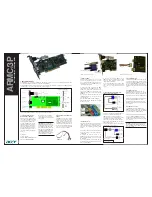
Scenario 1:4 – VLAN Tagging (802.1Q) with a Shared Uplink Set (SUS) with Link Aggregation using LACP (802.3ad) –
Windows 56
a.
Enclosure 1, Bay 1, Port 1
b.
Enclosure 1, Bay 1, Port 2
c.
Enclosure 1, Bay 2, Port 1
d.
Enclosure 1, Bay 2, Port 2
•
Add Networks as follows;
a.
PROD-A = VLAN ID=101
b.
PROD-B = VLAN ID=102
c.
PROD-B = VLAN ID=103
d.
PROD-B = VLAN ID=104
•
Leave Connection Mode as Auto
Note: By creating a SUS we have provided the ability to present one or many VLANs to a server NIC.
As two uplinks are configure from each VC module and the SAME SUS we have provided an
active/standby configuration with Link Aggregation (802.3ad, LACP). This configuration provides
additional bandwidth and the ability to lose an uplink cable, network switch or depending on how the
NICs are configured at the server (teamed or untamed), even a VC module. However, only one uplink
pair will be active at a time.
Note: Smart Link – In this configuration Smartlink should NOT be enabled. Smartlink is used to turn off
downlink ports within Virtual Connect, if ALL available uplinks to a vNet or SUS are down.
Defining a new Shared Uplink Set via CLI
#Create Shared Uplink Set "VLAN-Trunk-1" and configure an uplink on VC Module 1, Port 1 and VC
Module 2, Port 1
add uplinkset VLAN-Trunk-1
add uplinkport enc0:1:1 Uplinkset=VLAN-Trunk-1 speed=auto
add uplinkport enc0:1:2 Uplinkset=VLAN-Trunk-1 speed=auto
add uplinkport enc0:2:1 Uplinkset=VLAN-Trunk-1 speed=auto
add uplinkport enc0:2:2 Uplinkset=VLAN-Trunk-1 speed=auto
# Create Networks VLAN_101 and VLAN_104 for Shared Uplink Set "VLAN-TRUNK-1"
add network PROD-A uplinkset=VLAN-Trunk-1 VLanID=101
add network PROD-B uplinkset=VLAN-Trunk-1 VLanID=102
add network PROD-C uplinkset=VLAN-Trunk-1 VLanID=103
add network PROD-D uplinkset=VLAN-Trunk-1 VLanID=104
















































